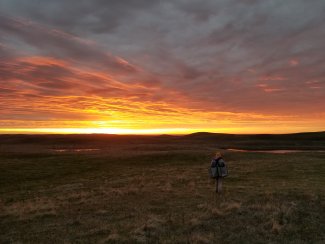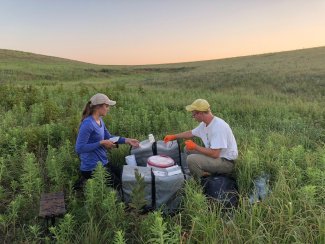Small Mammals
Field mouse on the forest floor in Domain 05, the Great Lakes
Small mammals are abundant in nearly every ecosystem and fill an important ecological niche. As secondary consumers, they have a significant impact on plant communities. They are also a primary food source for a broad range of predators. Small mammal studies have long been used to generate insights into patterns of diversity, community assembly, and interspecies interactions within an ecosystem.
Because they have relatively high reproductive rates, small mammals respond quickly to changes in long-term weather changes, land use, and habitat. Studying small mammal abundance and diversity over time can help us understand how ecosystems are changing. Long-term studies of small mammal communities can help researchers examine critical questions in ecological dynamics, including how ecosystems respond to extreme events, land use changes, temperature shifts, and the introduction of invasive species into a habitat. These studies can also answer fundamental questions about interspecies dependence, resource limitation, and relationships between species richness and community structure.
Small mammals are also of interest because they transmit pathogens that can infect other animal species, including humans. Human diseases that are caused by rodent-borne pathogens include Hantavirus Pulmonary Syndrome, Hemorrhagic Fever, Lassa Fever, Leptospirosis and Plague. Small mammals also serve as reservoir hosts for a wide variety of tick-borne pathogens. Monitoring the abundance and range of species known to carry pathogens is important for public health.
The NEON program conducts field sampling of small mammals such as rats, mice, and voles at most terrestrial field sites (excluding the sites in Hawaii and Puerto Rico). Studying the individual traits and population trends in small mammal species in an ecosystem provides important insights into how ecosystems are changing in response to shifts in long-term weather changes, land use, or the introduction of invasive species. Some small rodents are also reservoirs for pathogens that can be spread to humans.
Sampling Design and Methods

Small mammal sampling at DCFS at sunset
Small mammals are sampled at 44 terrestrial sites across 18 NEON Domains. The small mammal protocol is excluded from D20 (Hawaii, site PUUM) due to endangered species requirements. Sampling of small mammals in D04 (Puerto Rico sites GUAN and LAJA) was conducted in 2016-2017 and then suspended indefinitely, though the data are still available.
- Field scientists use Sherman live traps, which are placed on the ground and baited. Trap size, type and recommendations for covering traps are specific to each site and the targeted small mammals to be collected.
- Traps are baited and set near sunset and checked at first light (within 30 minutes of civil twilight). Where possible, traps are left in situ and kept closed during daylight hours to avoid trapping of diurnal animals.
- Field researchers check traps daily during the trapping period. Trapped individuals are collected, and field processed before being released back to the environment.
- In hot weather, special measures are taken to reduce heat stress resulting from exposure of the trap to direct sunlight, including placement of traps into shaded conditions during animal processing, and earlier checking of traps. In cold weather, polyester or wool batting may be added to the traps for insulation. At all times, measures are taken to reduce stress for trapped individuals during collection, handling and processing.
- All animal protocols have been approved by Battelle's Institutional Animal Care and Use Committee (IACUC).
At most sites, a total of six small mammal grids are trapped in each bout of sampling. Some smaller sites have fewer than six grids due to distance requirements between grids and from roads. A trapping grid is 90m x 90m and set up within the dominant vegetation type(s) for the field site.
- Sherman box traps for small mammals are set in a grid pattern with ten rows and ten columns of traps set 10m apart, for a total of 100 traps within the sampling plot.
- Three grids within each field site are designated as pathogen grids. The remaining grids are designated as diversity grids.
- This grid design is widely employed across a range of small mammal studies, facilitating comparison with a greater number of data sets, and it can be used with a range of analysis techniques, including spatially-explicit capture-recapture (SECR) models.
Trapping is conducted in bouts six times per year at core terrestrial field sites and four times per year at other terrestrial field sites.
- Trapping is conducted on a lunar schedule within 10 days before or after the new moon.
- Trapping is conducted for three consecutive nights on the pathogen grids and on a single night for diversity grids.
Collection
For the NEON program, small mammals are defined as mammals that are 1) non-volant (unable to fly); 2) nocturnal; 3) forage predominantly aboveground; and 4) weigh more than 5 grams but less than approximately 500-600 grams. This includes a number of small rodents including cricetids (New World rats and mice, lemmings, voles, true hamsters), dipodids (birch mice, jumping mice, jerboas), heteromyids (kangaroo rats), small sciurids (squirrels, flying squirrels), and introduced murids (Old World rats and mice, gerbils). It does not include lagomorphs (rabbits, hares, pikas), mustelids (weasels), large squirrels, or soricids (shrews), although these other taxa may be incidentally captured.
Small mammal sampling is conducted in order to study small mammal community structure and composition as they relate to climate, productivity, and insect abundance as well as the dynamics of demography, population density, and disease prevalence. NEON small mammal sampling produces three data sets, including box-trapping data, DNA sequencing data, and rodent-borne pathogen status. In addition, a variety of biological samples are collected from the rodents and archived.

Field technicians conducting small mammal sampling at the KONZ field site
Processing and Lab Analysis
Captured small mammals are identified to species and assessed for sex, age, and reproductive condition. Researchers also take standard and species-specific measurements. Standard measurements include weight and hind foot length. Additional species-specific measures may include ear length, tail length, or total length. Individuals are also assessed for the presence of ticks by life stage as well as a binned quantity (1-5, 6-20, >20). All processing is completed in the field to allow for quick release of captured individuals at the point of capture.
Blood draws are taken from some individuals prior to release for pathogen testing. Pathogen testing is conducted on collected specimens that are considered to be in good condition. Blood samples are frozen on dry ice in the field and sent to an outside laboratory for pathogen testing. Samples were tested for seropositivity to Hantaviruses through 2019. Blood samples collected after 2019 are tested for tick-borne pathogens including (but not limited to) Borrellia spp., Anaplasma phagocytophilum, Rickettsia ricketsii, and Francisella tularensis. The DNA extracts from all tested blood samples are available from the NEON Biorepository for further analysis. Additional information on pathogens can be found on the Pathogens Data Collection page as well as in the Data Product User Guide.
Ear punches are collected from captured individuals for further analysis or archiving. Ear tissue samples from sites in or adjacent to Domains where Borrelia burgdorferi has been detected in ticks will be tested for Borrelia burgdorferi because this pathogen is more readily detected in tissue than in blood samples. The DNA extracts from all tested ear samples are available from the NEON Biorepository for further analysis. An additional subset of ear tissue samples are preserved in a tissue vial and sent to an outside lab for DNA analysis. DNA analysis enables definitive species identification as well as genomic analysis for population studies.
Before release, additional biological samples may be collected, including hair, whiskers, and feces. These samples are labeled and preserved in the field and sent to the NEON Biorepository for archiving, where they are available for further analysis funded and organized by outside researchers.
Species with ears suitable for tagging are tagged with a self-piercing small animal ear tag laser-etched with NEON on one side and an identification number on the other. For species whose ears are lacking sufficiently long pinnae for ear tagging, Passive Integrated Transponder (PIT) tags are used. Tagging allows individuals to be identified upon recapture.
A subset of trapped specimens (voucher specimens) are retained for analysis and archiving. These specimens provide a long-term reference to document changes in species traits over time or provide evidence to support taxonomic changes. Archived specimens include whole animals and skin, skeleton, and frozen tissue (e.g., heart, liver) samples. Whole specimens and tissue samples are stored in the NEON Biorepository and are available for further analysis funded and organized by outside researchers.
All animal handling and processing is conducted according to protocols that have been reviewed and approved by Battelle's Institutional Animal Care and Use Committee (IACUC). If capture rates are high, some processing steps may be omitted for some individuals in order to minimize the time they are held. Handling time per individual must be 15 minutes or less, and the condition and stress levels of each individual are monitored closely during handling.
Data Products
For data products of small mammals:
- Small Mammal Box Trapping (DP1.10072.001)
- Small Mammal Sequences DNA Barcode (DP1.10076.001)
For data products of rodent-borne pathogens:
- Rodent-borne Pathogen Status (hantavirus) (DP1.10064.001)
- Rodent-borne Pathogen Status (tick-borne pathogens) (DP1.10064.002) (update pending)
Archival Samples
Both whole specimen and tissue samples are available for use from the NEON Biorepository. Samples may include preserved whole specimens (for trait analysis), ear punches, hair and whisker samples, biological tissues (skin, organs) and feces. Some samples are available for destructive purposes and others for non-destructive research purposes only. NEON also archives small mammal DNA extractions.
| Types of Samples* | Storage Condition | Storage Container | Quantity Archived (Annually) † | Link to the Collection |
|---|---|---|---|---|
| Blood samples | -196°C | 2 mL cryovials | 1,600 to 2,100 vials | Mammal Collection (Blood Samples) (NEON-MAMC-BL) |
| Ear tissue | -196°C | 2 mL cryovials | 450 to 550 samples | Mammal Collection (Ear Tissue) (NEON-MAMC-EA) |
| Genomic extracts, from pathogen testing | -196°C | 2 mL cryovials | 500 to 5,475 vials | NEON Biorepository |
| DNA extracts from ear tissue | -80°C | 96-well plates‡ | 1,850 to 1,950 extracts | Mammal Collection (DNA Extracts) (NEON-MAMC-DNA) |
| Fecal samples | -196°C | 2 mL cryovials | 4,500 to 9,600 samples | Mammal Collection (Fecal Samples) (NEON-MAMC-FE) |
| Hair and Whiskers | dry | archival coin envelopes | 3,200 to 5,800 samples | Mammal Collection (Hair Samples) (NEON-MAMC-HA) |
| Small mammals, whole vouchers | Frozen dry or 95% ethanol | individual or lots | 600 to 900 individuals | Mammal Collection (Vouchers [Standard Sampling at Pathogen Plots]) (NEON-MAMC-VPP) |
* Select specimens collected from 2013-2017 and most specimens collected after 2018 are archived at the NEON Biorepository at Arizona State University. See table below for information about the archive locations of early (2013-2017) material.
† Quantities represented in this table are annual quantities expected from sampling conducted throughout the observatory during full Operations. Actual quantities may differ from these projections
‡ Quantities are number of samples (not number of well plates); up to 96 samples are contained on the same well plate
Some legacy material is curated at other institutions, where material was archived before the creation of the NEON Biorepository. NEON is required to continue archiving some materials (e.g., mammal specimens collected in Florida) at these institutions due to permitting requirements that specify certain material must reside in the state where it was originally collected.
| Archive Institution | Collection Years | Types of Samples | Link to the Collection |
|---|---|---|---|
| Museum of Southwestern Biology at the University of New Mexico | 2013-2017 | blood, ear tissue, feces, hair & whiskers, whole vouchers | Link |
| Florida Museum of Natural History | 2013 - ongoing | mammal vouchers [only specimens collected from Florida] | Link |